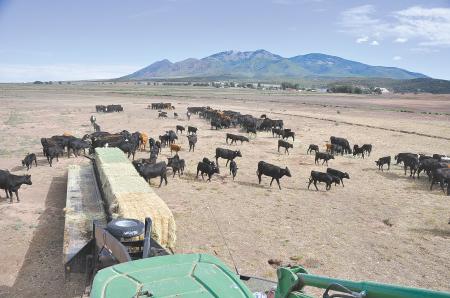 The Sinch Bale Feeder feeds out up to 10 large
square bales fast and easy. Designed for larger operations, the chain-drive kit
mounts to trailers with or without flakers to peel off hay and silage. It also
comes in a 6-bale detachable model that can sit on any flatbed trailer or
truck.
The Sinch Bale Feeder feeds out up to 10 large
square bales fast and easy. Designed for larger operations, the chain-drive kit
mounts to trailers with or without flakers to peel off hay and silage. It also
comes in a 6-bale detachable model that can sit on any flatbed trailer or
truck.
“In 2006, we wanted to bring back silage to our 500-cow dairy in New South Wales,” explains Australian farmer Gerard Kenna, Sinch Bale Feeders. “There weren’t that many big square balers in use at the time or ways to feed the bales.”
Kenna came up with the idea of a cable- powered unloading platform. Initially he says there were a lot of headaches with cables needing to be replaced yearly. After 4 or 5 years of refinements, he came across a chain and sprocket used in the mining industry. It eliminated a second hydraulic motor and parts problem.
“Since 2012 we haven’t had to issue a single spare part or had a breakage,” says Kenna. “The chain and drive sprocket are pretty much unbreakable. They have at least 7 times the strength needed for a maximum bale load.”
Mounted in a channel running front to back and centered on the trailer, the chain pulls the pushing arm that moves the bales to the rear. The arm gradually pushes off bales on one side of the platform, returns to the front and is swung over to push off bales on the other side of the platform. With twines cut, the sections gradually fall off. An optional flaker provides more control.
A set of ropes attached to the arm can be used to capture bale twine or netting. Kenna suggests gathering the twines from a bale as they are cut and tying them with a rope. As the hay or silage is fed out, the rope holds the twines for later removal.
“The ropes eliminate having to pull the twines, and you always know you have them all,” says Kenna.
The simple unit requires only 2 hydraulic hoses, one hydraulic motor, and a single control lever in the cab. Even lubrication is kept to a minimum with one grease zerk on the basic unit and 4 on those with flakers.
As the farm began using the feeder, he reports the biggest surprise was the straight-up savings in labor. One man could do what required several in the past.
“One customer who fed out 180 big square bales of hay and silage a week reported going from 6 workers to one,” says Kenna. “
The safety of the system, with just an operator sitting in the cab, was the next biggest thing.
Another surprise was the system’s versatility. Sinch systems are adaptable to a variety of trailers and truck beds.
Utah rancher Charles Redd was the first North American buyer. He wanted to install the platform as a 10-bale unit on a 40-ft. gooseneck trailer. Kenna traveled to Utah and reviewed the plans and components with a local welding firm.
“Within a month, they had it operational,” says Kenna. “I was amazed at the suitability of gooseneck trailers, which we don’t have in Australia. We have since found a manufacturer in Oregon who will do the entire installation on goosenecks.”
Six-bale kits installed on 25-ft. gooseneck trailers in the U.S. start at an introductory price of $19,035. An 8-bale kit on a 33-ft. gooseneck trailer starts at $27,810. Flakers are extra.
“Trailers can be built specifically for 6 or 8 bales or for heavier loads,” says Kenna. “Let us know so we can tailor the whole package to your individual needs.”
